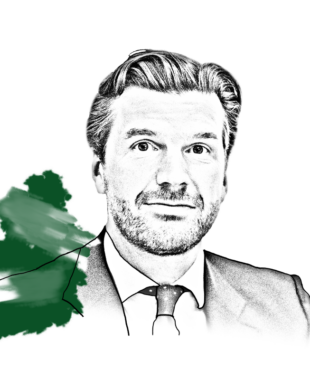Less than half a mile from our offices in Charlotte Square, Edinburgh, is the birthplace of Alexander Wood, the physician credited with inventing the hypodermic syringe in 1853. His all-glass syringe with plunger and needle was revolutionary in ensuring drugs could be administered in a precise and controlled manner. More than 170 years later, medical technology has evolved beyond anything Dr Wood could have imagined. As with most things technological in recent decades, much of the innovation is taking place in California.
At the end of August, I spent a week there, meeting with 21 companies across the medtech industry, all engaged in pioneering technologies, from robotic-assisted surgery and continuous glucose monitoring to DNA synthesis and liquid biopsy screening technologies. These meetings were a reminder of the remarkable levels of innovation that have been generated in recent years. Many of the technologies that have been developed are now commercialised and, in some cases, have become the standard of care in their respective therapeutic areas.
It has been a long and expensive grind for many companies
However, such success does not come without challenges. It has been a long and expensive grind for many companies. Understandably, any new technology in the field of medicine requires extensive clinical trials, reimbursement agreements and the education of both practitioners and regulators. More broadly, there has been a lot of pressure on the entire industry of late. The post-Covid blues, tighter regulations and failures to meet market expectations have taken their toll. On top of this, there has been the suggestion that GLP-1 drugs can reduce the need for medical devices used in treatment of diseases that are correlated with obesity.
Peer pressure
Competition has also intensified. Many of the companies that I met are now experiencing real pressures as “fast followers” catch up. They need to prove that they have the superior products and competitive edge. Intuitive Surgical is one such business. It designs and manufactures robotic systems to assist in performing minimally invasive surgeries. I last visited Intuitive’s Sunnyvale headquarters in February, when its latest robot, the da Vinci 5, had been unveiled but was yet to be approved by the US Food and Drug Administration (FDA) so this was a useful update now it is in use in hospitals.
A business like Intuitive has strong, strategic client relationships
The da Vinci 5 has 150 additional design features and 10,000x the computing power of the previous model. These enhancements include, amongst other features, the advanced analytics to harness Intuitive’s decades of surgical data. With more than 14.2 million procedures performed to date across the da Vinci systems currently in use, the number of possible data points are almost infinite.
The company’s new president David Rosa clearly envisages a future where this robot is critical to the operating theatre. So far, the da Vinci 5 is being rolled out carefully and the feedback from hospitals has been positive, according to Rosa. A business like Intuitive has strong, strategic client relationships, and is continuously strengthening its moat, making it difficult for others to come close.
At the other end of the scale, I met with Insulet, which produces automated insulin-injecting pump patches. The patches are connected to continuous glucose monitors (CGM) and ensure an accurate and consistent dosage of insulin for Type 1 and 2 diabetes patients. Insulet’s Type 1 setting has been approved for some time but the company recently received approval for the Type 2 patient population which would be a much larger market, with approximately two million patients in the US alone. However, Insulet could be facing competition from its rival, Tandem, which is also pursuing Type 2 approval and may enter the market soon.
Tougher operating environment
The potential GLP-1 risk is also a concern when it comes to this business. Clinical data published earlier this year demonstrated Eli Lilly’s GLP-1 tirzepatide’s ability to potentially delay the progress of medicated patients into the insulin-intensive setting. These results add to the suggestion that Eli Lilly and Novo Nordisk’s GLP-1 drug usage could be expanded beyond obesity and diabetes.
I also spoke with Dexcom, a more high-profile CGM player, which has had a spectacular fall from grace. Concerns about the intensified competition risks and GLP-1s loom large whilst the company is also materially resetting its guidance due to some self-inflicted operational issues around restructuring of its salesforce and market share losses.
ResMed has a large data pool, with over 19 billion nights’ sleep
Unsurprisingly, it’s not only diabetes-related companies which are in thrall to GLP-1s. ResMed designs and manufactures products that treat the likes of obstructive sleep apnoea (OSA). It is estimated that 58% of moderate to severely obese patients have OSA. This is a condition which ResMed’s devices and masks help to treat through continuous positive airway pressure therapy (CPAP). Given the fact that GLP-1s are anti-obesity drugs, they are very likely to have an impact on this business. According to ResMed’s CEO Michael Farrell, this impact will be positive. Earlier this year Eli Lilly applied to the FDA for approval to use its Zepbound GLP-1 to treat OSA. Despite this, Farrell makes the point that CPAP is the cheaper option for insurers. He is also confident on the outlook when it comes to ResMed’s devices and GLP-1 usage.
Like Intuitive, ResMed has a large data pool, with over 19 billion nights’ sleep so that they can analyse how people interact with CPAP devices while also taking GLP-1s. At the end of one year, the company reports that it is more likely that patients will still be on CPAP than a GLP-1. As ResMed starts to roll out its generative AI “Dawn” app in the US, this data will help to strengthen its competitive edge.
Technology requires training
One of the problems with fast-paced technological progress in the medical sphere is the dangers that the advances could outpace what the doctors can handle. This is a challenge that Edwards Lifesciences has had to contend with of late. Discussing this with the company, both on this trip and on a call with the new CEO Bernard Zovighian in July, there appear to be capacity issues at some catheterisation labs, where cardiology investigations and treatments are carried out. Edwards’ own transcatheter aortic valve replacement (TAVR) procedures, which treat aortic stenosis (AS), are being crowded out by new technologies, including some of Edwards’ own devices. Doctors are having to contend with the training for new unfamiliar heart surgeries, causing serious inefficiencies at the busiest surgical centres.
Big tech is also, unsurprisingly, getting in on the actions
AS is a serious heart condition that affects millions around the world. It develops when the calcification of the aortic valve stops it from functioning properly. Mortality rates from severe AS when symptoms first appear are around 50% within two years without valve replacement. Most AS sufferers are over the age of 65 so prevalence continues to grow as populations age. Zovighian was keen to stress that any current capacity issue was transitory and that TAVR growth will continue due to the huge number of AS patients who have yet to be diagnosed.
The area of diagnostics is likely to be a significant area of growth and is not limited to the established medtech businesses. Big tech is also, unsurprisingly, getting in on the action. Apple and Samsung have both had FDA approval for features on their respective watches to identify whether wearers have an irregular heart rate. Samsung has also had a feature that detects signs of sleep apnoea approved. This is good news for the likes of ResMed, as people use these wearables to become aware of possible health conditions which then lead them towards CPAP and other devices.
There are other external factors at play which will improve the backdrop for the medtech industry. The life sciences sector is finally coming out of its destocking trough post Covid. I got the sense that optimism is in the air with biotech funding back on track. Ditto with big pharma, which has had a difficult few years, it feels like it is recovering slowly.
Post-trip contemplation
Back in Edinburgh and reflecting on the trip, I wonder whether the recent wave of medtech innovation is maturing and if future rates will inevitably slow down as some companies pare back their R&D spending. The extraordinary levels of innovation we have witnessed reflect the outsized investment spending committed in an era of easy money. This will particularly affect those companies without financial discipline and a strong balance sheet. As the investment environment has changed more recently, with higher-for-longer interest rates, this will surely have implications for the industry’s future technological progress.
That said, I have no doubt that the US will continue to be home to the world’s leading medtech innovators for many years to come. It is important to be invested in the very best of those businesses, those with the financial strength and competitive edge to prosper over the long term.
Important Information
This article is provided for general information only and should not be construed as investment advice or a recommendation. This information does not represent and must not be construed as an offer or a solicitation of an offer to buy or sell securities, commodities and/or any other financial instruments or products. This document may not be used for the purpose of an offer or solicitation in any jurisdiction or in any circumstances in which such an offer or solicitation is unlawful or not authorised.
Stock Examples
The information provided in this article relating to stock examples should not be considered a recommendation to buy or sell any particular security. Any examples discussed are given in the context of the theme being explored.


